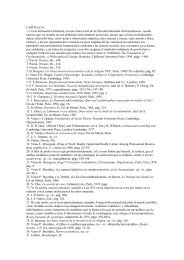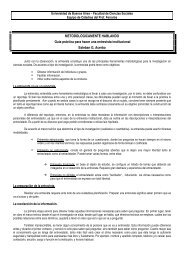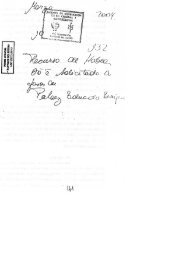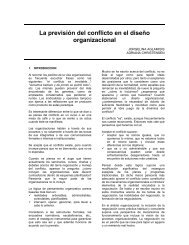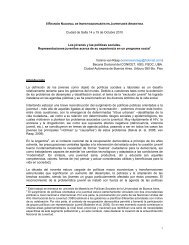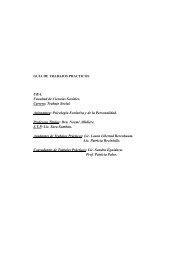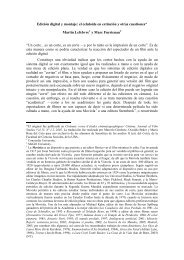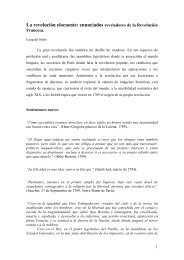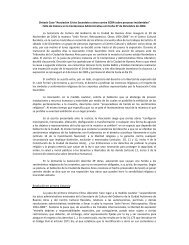Reinventing Local Governments and the E-Government Initiative
Reinventing Local Governments and the E-Government Initiative
Reinventing Local Governments and the E-Government Initiative
You also want an ePaper? Increase the reach of your titles
YUMPU automatically turns print PDFs into web optimized ePapers that Google loves.
Alfred Tat-Kei Ho<br />
Iowa State University<br />
<strong>Reinventing</strong> <strong>Local</strong> <strong><strong>Government</strong>s</strong> <strong>and</strong> <strong>the</strong><br />
E-<strong>Government</strong> <strong>Initiative</strong><br />
The Internet provides a powerful tool for reinventing local governments. It encourages transformation<br />
from <strong>the</strong> traditional bureaucratic paradigm, which emphasizes st<strong>and</strong>ardization, departmentalization,<br />
<strong>and</strong> operational cost-efficiency, to <strong>the</strong> “e-government” paradigm, which emphasizes<br />
coordinated network building, external collaboration, <strong>and</strong> customer services. Based on a<br />
content analysis of city Web sites <strong>and</strong> a survey of Web development officials, this article shows<br />
that many cities are already moving toward this new paradigm. These cities have adopted “onestop<br />
shopping” <strong>and</strong> customer-oriented principles in Web design, <strong>and</strong> <strong>the</strong>y emphasize external<br />
collaboration <strong>and</strong> networking in <strong>the</strong> development process ra<strong>the</strong>r than technocracy. The article<br />
also analyzes <strong>the</strong> socioeconomic <strong>and</strong> organizational factors that are related to cities’ progressiveness<br />
in Web development <strong>and</strong> highlights future challenges in reinventing government through<br />
Internet technology.<br />
Introduction<br />
When <strong>the</strong> Department of Defense invented <strong>the</strong> Internet<br />
in <strong>the</strong> 1960s as a communication network for defense research<br />
purposes, no one could have foreseen how it would<br />
transform society three decades later. Today, <strong>the</strong> Internet<br />
has become a part of <strong>the</strong> daily life of many Americans.<br />
Between 1990 <strong>and</strong> 1998, <strong>the</strong> number of computers attached<br />
to <strong>the</strong> Internet grew exponentially, from less than 1 million<br />
to about 30 million (Comer 1999, 8–11). Between 1989<br />
<strong>and</strong> 1997, <strong>the</strong> use of network services from ei<strong>the</strong>r home or<br />
work increased from 6 percent of individuals to 23 percent<br />
(Neu, Anderson, <strong>and</strong> Bikson 1999, 119–23). By 2000, <strong>the</strong><br />
number of Internet users was estimated to be over 110<br />
million (GAO 2000, 1).<br />
Explosive growth in Internet usage <strong>and</strong> rapid development<br />
of e-commerce in <strong>the</strong> private sector have put growing<br />
pressure on <strong>the</strong> public sector to serve citizens electronically,<br />
which is often known as <strong>the</strong> “e-government”<br />
initiative. The initiative is to provide public services <strong>and</strong><br />
to empower citizens <strong>and</strong> communities through information<br />
technology, especially through <strong>the</strong> Internet. In <strong>the</strong><br />
early 1990s, city governments began to use electronic<br />
mail, listserv, <strong>and</strong> <strong>the</strong> World Wide Web to deliver information<br />
<strong>and</strong> services. By <strong>the</strong> end of <strong>the</strong> 1990s, Web-based<br />
services were already an integral <strong>and</strong> significant part of a<br />
new “e-government.”<br />
434 Public Administration Review • July/August 2002, Vol. 62, No. 4<br />
However, <strong>the</strong> Internet has brought more than a technological<br />
breakthrough in service delivery. It has stimulated<br />
a transformation in <strong>the</strong> philosophy <strong>and</strong> organization<br />
of government. This article first sets <strong>the</strong> stage for an<br />
analysis of this trend by contrasting <strong>the</strong> traditional bureaucratic<br />
paradigm with <strong>the</strong> new e-government paradigm.<br />
It <strong>the</strong>n presents an analysis of <strong>the</strong> official city Web sites<br />
of <strong>the</strong> 55 largest cities in <strong>the</strong> United States <strong>and</strong> <strong>the</strong> results<br />
of a survey of city Web masters, which demonstrate that<br />
<strong>the</strong> transformation is already under way. The article also<br />
analyzes socioeconomic <strong>and</strong> organizational barriers to <strong>the</strong><br />
transformation <strong>and</strong> challenges government leaders to<br />
think differently in <strong>the</strong> twenty-first century to overcome<br />
<strong>the</strong>se barriers.<br />
A Paradigm Shift of Public Service<br />
Delivery in <strong>the</strong> Internet Age<br />
Alfred Ho is an assistant professor in <strong>the</strong> Program of Public Policy <strong>and</strong> Administration<br />
of <strong>the</strong> Political Science Department at Iowa State University. His<br />
research focuses primarily on state <strong>and</strong> local finance <strong>and</strong> policies <strong>and</strong> information<br />
technology management. His publications have appeared in <strong>the</strong><br />
American Review of Public Administration, Public Administration Quarterly,<br />
<strong>and</strong> Research in Public Administration. In 1999, Ho was a member of <strong>the</strong><br />
<strong>Government</strong> Section of <strong>the</strong> Iowa Governor’s Y2K Council. Email: alfredho<br />
@iastate.edu.
Challenges to <strong>the</strong> Traditional Model of<br />
Bureaucracy<br />
People usually think of government as a hierarchical<br />
bureaucracy. This model, commonly known as <strong>the</strong><br />
Weberian model of organization, focuses on internal <strong>and</strong><br />
managerial concerns <strong>and</strong> emphasizes departmentalization,<br />
specialization, st<strong>and</strong>ardization, <strong>and</strong> routinization of <strong>the</strong><br />
production process (Weber 1947; Simon 1976; Schachter<br />
1994). Officials who perform similar functions are<br />
grouped <strong>and</strong> organized into <strong>the</strong> same administrative unit<br />
or department. Each unit is responsible for underst<strong>and</strong>ing<br />
its clients, assessing <strong>the</strong> dem<strong>and</strong> for its services, delivering<br />
those services, <strong>and</strong> setting administrative goals<br />
for planning <strong>and</strong> evaluation purposes. To ensure that departmental<br />
plans are consistent with each o<strong>the</strong>r <strong>and</strong> fiscally<br />
feasible, <strong>the</strong> budget office, city manager’s or mayor’s<br />
office, <strong>and</strong> <strong>the</strong> city council are responsible for centralized<br />
control <strong>and</strong> coordination.<br />
One advantage of <strong>the</strong> Weberian bureaucracy is that <strong>the</strong><br />
transaction costs of official communication <strong>and</strong> coordination<br />
are reduced through departmentalization <strong>and</strong><br />
routinization (Williamson 1975; Galbraith 1977). This approach<br />
encourages professional specialization <strong>and</strong> maximizes<br />
efficiency <strong>and</strong> potential economies of scale (North<br />
1981). Fur<strong>the</strong>rmore, through rules, regulations, <strong>and</strong> hierarchical<br />
supervision, <strong>the</strong> bureaucratic model reduces <strong>the</strong><br />
chances of unintentional errors, fraud, negligence, <strong>and</strong> opportunistic<br />
behaviors by officials (Williamson 1975; Perrow<br />
1986) <strong>and</strong> ensures <strong>the</strong> equitable treatment of clients.<br />
However, <strong>the</strong> Weberian bureaucracy is often criticized<br />
for its rigidity, proceduralism, inefficiency, <strong>and</strong> incapability<br />
to serve “human clients,” who have preferences <strong>and</strong><br />
feelings (Hummel 1992; Rainey, Paney, <strong>and</strong> Bozeman<br />
1995; Bozeman 2000). A simple example of <strong>the</strong>se drawbacks<br />
is <strong>the</strong> fact that a newcomer to a city may have to fill<br />
out many different forms for <strong>the</strong> utility department, <strong>the</strong><br />
assessor’s office, <strong>and</strong> <strong>the</strong> recorder’s office, even though<br />
<strong>the</strong> forms ask for similar information, such as name, address,<br />
<strong>and</strong> household characteristics.<br />
The “reinventing government” movement, which started<br />
in <strong>the</strong> late 1980s, is an effort to reorient <strong>the</strong> focus of government<br />
operations from an inward-looking approach to<br />
an outward-looking one by emphasizing <strong>the</strong> concerns <strong>and</strong><br />
needs of end users. Under <strong>the</strong> model proposed by Osborne<br />
<strong>and</strong> Gaebler (1992), citizens are regarded as “customers”<br />
who become <strong>the</strong> central focus in designing government<br />
service delivery. 1 This model also emphasizes <strong>the</strong> principles<br />
of “catalytic government” <strong>and</strong> “community-ownership.”<br />
Public officials are challenged to think about how to empower<br />
citizens to take ownership of community problems.<br />
The approach urges officials to partner with citizen groups<br />
<strong>and</strong> nonprofit organizations to identify solutions <strong>and</strong> deliver<br />
public services effectively.<br />
However, a major obstacle to <strong>the</strong> reinventing government<br />
reform is <strong>the</strong> burden of transaction costs imposed on<br />
public officials <strong>and</strong> citizens. <strong>Government</strong> officials may find<br />
citizen engagement time consuming <strong>and</strong> costly. Given <strong>the</strong><br />
time pressure <strong>the</strong>y already face in <strong>the</strong> daily operation of<br />
government, networking with citizens <strong>and</strong> proactively soliciting<br />
public input seem an unnecessary <strong>and</strong> unwanted<br />
burden. Citizens also may be reluctant to participate in <strong>the</strong><br />
decision-making process of <strong>the</strong> government. Attending<br />
meetings, writing formal feedback, <strong>and</strong> responding to surveys<br />
about public services may require a time commitment<br />
that many citizens are not willing to give regularly.<br />
As Schachter (1995) suggests, “more fundamentally, many<br />
individuals do not underst<strong>and</strong> why <strong>the</strong>y might want to take<br />
<strong>the</strong> trouble to seek [out] information [about government<br />
performance].… If we envision citizens as owners, <strong>the</strong>n it<br />
is a problem that <strong>the</strong> proprietors lack <strong>the</strong> psychological<br />
<strong>and</strong> informational resources to mind <strong>the</strong>ir own business”<br />
(535–36).<br />
The Role of <strong>the</strong> Internet in <strong>Reinventing</strong><br />
<strong>Government</strong><br />
It is in addressing <strong>the</strong>se challenges that information technology<br />
has played an increasingly important role in public<br />
administration (Gore 1993; Bellamy <strong>and</strong> Taylor 1998;<br />
Heeks 1999). Before <strong>the</strong> Internet emerged in <strong>the</strong> late 1980s,<br />
<strong>the</strong> government was already actively pursuing information<br />
technology to improve operating efficiency <strong>and</strong> to enhance<br />
internal communication (Kraemer <strong>and</strong> King 1977; King<br />
1982; Fletcher et al. 1992; Norris <strong>and</strong> Kraemer 1996;<br />
Brown 1999). However, <strong>the</strong> focus of e-government in this<br />
era was primarily internal <strong>and</strong> managerial.<br />
The arrival of <strong>the</strong> Internet <strong>and</strong> <strong>the</strong> World Wide Web<br />
marked a watershed in information technology usage by<br />
shifting <strong>the</strong> focus of governance to its external relationship<br />
with citizens (Scavo <strong>and</strong> Shi 1999; Seneviratne<br />
1999). Technology certainly played an important role in<br />
fostering <strong>the</strong> change. From <strong>the</strong> newsgroup <strong>and</strong> commercial<br />
email technology started in <strong>the</strong> mid-1980s, to <strong>the</strong><br />
development of <strong>the</strong> World Wide Web <strong>and</strong> Web browser<br />
technology in <strong>the</strong> early 1990s (Zakon 2000), <strong>the</strong> Internet<br />
gradually has matured into a cost-effective <strong>and</strong> userfriendly<br />
platform for officials to communicate directly<br />
with citizens <strong>and</strong> to deliver massive quantities of information<br />
to <strong>the</strong> public.<br />
The rise of e-commerce in <strong>the</strong> private sector fur<strong>the</strong>r reinforced<br />
<strong>the</strong> shift in <strong>the</strong> focus of government. The Internet<br />
allows not only companies but also individual citizens to<br />
exchange information <strong>and</strong> conduct business transactions<br />
cost-efficiently. The flexibility of <strong>the</strong> Internet in providing<br />
access to goods, services, <strong>and</strong> information raises citizens’<br />
expectations of customer service in a range of contexts,<br />
including interactions with government. Many now expect<br />
<strong>Reinventing</strong> <strong>Local</strong> <strong><strong>Government</strong>s</strong> <strong>and</strong> <strong>the</strong> E-<strong>Government</strong> <strong>Initiative</strong> 435
to find what <strong>the</strong>y need to know about <strong>the</strong> government on<br />
<strong>the</strong> Web around <strong>the</strong> clock, seven days a week.<br />
As a result of technological advancement <strong>and</strong> economic<br />
changes, policy makers have had fur<strong>the</strong>r incentive to shift<br />
<strong>the</strong> focus of information technology usage from internal<br />
managerial needs to external linkages with <strong>the</strong> public. The<br />
National Performance Review report (Gore 1993) suggests<br />
that e-government “will allow citizens broader <strong>and</strong><br />
more timely access to information <strong>and</strong> services through<br />
efficient, customer-responsive processes—<strong>the</strong>reby creating<br />
a fundamental revision in <strong>the</strong> relationship between<br />
<strong>the</strong> federal government <strong>and</strong> everyone served by it.” These<br />
remarks clearly reflect a new way of thinking about public<br />
service delivery.<br />
The Reemergence of “One-Stop Service Centers”<br />
The philosophical change outlined above rejuvenated<br />
<strong>the</strong> idea of “one-stop service centers.” To be sure, <strong>the</strong> idea<br />
of “client-based” organization is not new. In <strong>the</strong> 1970s <strong>and</strong><br />
1980s, agencies involved in social services already were<br />
experimenting with this alternative organization model as<br />
a way of integrating government services <strong>and</strong> operations<br />
(Calista 1986; Rainey <strong>and</strong> Rainey 1986). However, such<br />
efforts often faced bureaucratic resistance <strong>and</strong> slack resource<br />
constraints (Rainey 1990). As a result, bureaucratic<br />
systems based on functional operations persisted in many<br />
public services.<br />
In <strong>the</strong> Internet age, <strong>the</strong> idea of “one-stop shopping” has<br />
resurfaced as an alternative to functional departmentalization.<br />
As Reschenthaler <strong>and</strong> Thompson (1996) suggest, computers<br />
erode economies of scale in hierarchical organization<br />
<strong>and</strong> offer new justification for <strong>the</strong> establishment of<br />
responsibility centers—an arrangement similar to <strong>the</strong> onestop<br />
service center. The state of Washington (1996), in its<br />
strategic information technology plan notes, “In <strong>the</strong> private<br />
sector, customers expect one-stop shopping—<strong>the</strong> ability<br />
to obtain diverse services in a timely, convenient <strong>and</strong><br />
user-friendly manner from a single source.… Increasingly,<br />
Figure 1 Public Service Delivery as “One-Stop Shopping”<br />
Citizens<br />
(users or<br />
clients)<br />
Stages of<br />
service<br />
delivery<br />
Need<br />
Need<br />
Need<br />
Need<br />
Dem<strong>and</strong><br />
perception<br />
Service<br />
center for<br />
<strong>the</strong> user<br />
group<br />
Need<br />
assessment<br />
<strong>and</strong> internal<br />
capacity<br />
analysis<br />
436 Public Administration Review • July/August 2002, Vol. 62, No. 4<br />
this same kind of one-stop service is dem<strong>and</strong>ed by citizens<br />
seeking government services <strong>and</strong> information” (7).<br />
A one-stop service center is an umbrella organization<br />
that operates on top of existing functional departments <strong>and</strong><br />
is intended to maximize <strong>the</strong> convenience <strong>and</strong> satisfaction<br />
of users through service integration. As <strong>the</strong> gateway for<br />
specific client groups such as businesses, residents, or visitors,<br />
<strong>the</strong> center collects information about user dem<strong>and</strong> for<br />
inquiries <strong>and</strong> service assistance <strong>and</strong> processes <strong>the</strong> information<br />
centrally. It <strong>the</strong>n coordinates with functional departments<br />
such as local police, city planning, <strong>and</strong> transportation<br />
to deliver public services <strong>and</strong> carry out wholistic<br />
planning (see figure 1).<br />
Unlike early “client-based” reforms in social services<br />
during <strong>the</strong> 1980s, <strong>the</strong> creation of one-stop service centers<br />
today does not require a massive reorganization <strong>and</strong> consolidation<br />
of personnel. With <strong>the</strong> help of information technology,<br />
such as local area networks <strong>and</strong> project management<br />
software, public managers at <strong>the</strong> service center easily<br />
can coordinate with functional departments to conduct central<br />
planning <strong>and</strong> provide integrated services. By avoiding<br />
massive reorganization, <strong>the</strong> reform is less likely to encounter<br />
bureaucratic resistance in implementation.<br />
The emergence of <strong>the</strong> World Wide Web fur<strong>the</strong>r facilitates<br />
<strong>the</strong> growth of a one-stop service center model because a<br />
government Web site can itself serve as a convenient <strong>and</strong><br />
cost-effective platform for centralized service provision.<br />
Businesses, residents, visitors, <strong>and</strong> intergovernmental liaisons<br />
easily can access public information <strong>and</strong> services related<br />
to <strong>the</strong>ir specific needs simply by clicking on different<br />
Web links in <strong>the</strong> city Web site. They can also contact government<br />
officials directly through email or online request<br />
forms to give feedback about specific issues.<br />
As a result, information technology <strong>and</strong> <strong>the</strong> Internet<br />
are transforming public administration in <strong>the</strong> digital era<br />
(see table 1). In <strong>the</strong> traditional bureaucratic paradigm,<br />
public managers focus on internal productive efficiency,<br />
functional rationality <strong>and</strong> departmentalization, hierarchi-<br />
Central<br />
integration<br />
mechanism<br />
(e.g., mayor’s<br />
office, budget<br />
office)<br />
Production<br />
planning <strong>and</strong><br />
appropriation<br />
Department 1 Need<br />
Department 2 Need<br />
Department 3 Need<br />
Department 4 Need<br />
Service<br />
provision<br />
Output,<br />
outcome,<br />
<strong>and</strong> impact<br />
evaluation
cal control, <strong>and</strong> rule-based management (Kaufman 1977;<br />
Bozeman 2000). In contrast, under <strong>the</strong> e-government paradigm—like<br />
<strong>the</strong> paradigm of information-technologybased<br />
organizations in <strong>the</strong> business world (Applegate<br />
1994; Wig<strong>and</strong>, Picot, <strong>and</strong> Reichwald 1997)—public managers<br />
shift from emphasizing producer concerns, such as<br />
cost-efficiency, to focusing on user satisfaction <strong>and</strong> control,<br />
flexibility in service delivery, <strong>and</strong> network management<br />
with internal <strong>and</strong> external parties. The new paradigm<br />
stresses innovation, organizational learning, <strong>and</strong><br />
entrepreneurship so that government can continue to reinvent<br />
itself. In addition, public service is no longer st<strong>and</strong>ardized<br />
in <strong>the</strong> new model. With <strong>the</strong> help of information<br />
technology, e-government can customize services based<br />
on personal preferences <strong>and</strong> needs.<br />
The new paradigm transforms organizational principles<br />
in government. While <strong>the</strong> bureaucratic model emphasizes<br />
top-down management <strong>and</strong> hierarchical communication,<br />
<strong>the</strong> new model emphasizes teamwork, multidirectional<br />
network, direct communication between parties, <strong>and</strong> a<br />
fast feedback loop (Reschenthaler <strong>and</strong> Thompson 1996;<br />
Rosell 1999, 13–15). Citizens no longer need to know<br />
which departments are responsible for what in <strong>the</strong> “network”<br />
production of services. The functional departmental<br />
structure <strong>and</strong> production process of public services behind<br />
<strong>the</strong> operation of <strong>the</strong> “one-stop service center” becomes<br />
“invisible” to users. This is not to suggest that central<br />
leadership is unimportant in e-government. However,<br />
leadership in <strong>the</strong> new paradigm encourages facilitation<br />
<strong>and</strong> coordination among parties, ra<strong>the</strong>r than hierarchical<br />
comm<strong>and</strong> <strong>and</strong> control.<br />
Table 1 Shifting Paradigms in Public Service Delivery<br />
Orientation<br />
Process organization<br />
Management principle<br />
Leadership style<br />
Internal communication<br />
External communication<br />
Mode of service delivery<br />
Principles of service<br />
delivery<br />
Bureaucratic paradigm E-government paradigm<br />
Production cost-efficiency<br />
Functional rationality,<br />
departmentalization, vertical<br />
hierarchy of control<br />
Management by rule <strong>and</strong><br />
m<strong>and</strong>ate<br />
Comm<strong>and</strong> <strong>and</strong> control<br />
Top-down, hierarchical<br />
Centralized, formal, limited<br />
channels<br />
Documentary mode, <strong>and</strong><br />
interpersonal interaction<br />
St<strong>and</strong>ardization, impartiality,<br />
equity<br />
User satisfaction <strong>and</strong><br />
control, flexibility<br />
Horizontal hierarchy,<br />
network organization,<br />
information sharing<br />
Flexible management,<br />
interdepartmental team<br />
work with central<br />
coordination<br />
Facilitation <strong>and</strong> coordination,<br />
innovative entrepreneurship<br />
Multidirectional network<br />
with central coordination,<br />
direct communication<br />
Formal <strong>and</strong> informal,<br />
direct <strong>and</strong> fast feedback,<br />
multiple channels<br />
Electronic exchange, non<br />
face-to-face interaction<br />
(so far)<br />
User customization,<br />
personalization<br />
Paradigm Shift Reflected in<br />
City Web Sites<br />
The orientations of city Web sites provide evidence that<br />
this paradigm shift is indeed taking place in city governments.<br />
If a city adopts <strong>the</strong> traditional bureaucratic paradigm,<br />
its Web site organization tends to be administratively<br />
oriented. Information is organized primarily according to<br />
<strong>the</strong> administrative structure of <strong>the</strong> government <strong>and</strong> does<br />
not reflect substantial rethinking of <strong>the</strong> bureaucratic process<br />
<strong>and</strong> organization in public service delivery. City governments<br />
commonly adopted this approach when <strong>the</strong>y began<br />
to form <strong>the</strong>ir first Internet presence in <strong>the</strong> 1990s.<br />
Cities that have shifted from <strong>the</strong> bureaucratic paradigm<br />
to <strong>the</strong> e-government paradigm design <strong>the</strong>ir Web sites differently.<br />
They tend to use two common approaches, commonly<br />
referred to as “portal designs.” The first one is <strong>the</strong><br />
“information-oriented” design, <strong>and</strong> <strong>the</strong> second is <strong>the</strong> “useroriented”<br />
design. Both require a breakdown of departmental<br />
thinking <strong>and</strong> a reorganization of information according to<br />
<strong>the</strong> users’ perspective <strong>and</strong> interest.<br />
The information-oriented approach applies <strong>the</strong> concept<br />
of “one-stop shopping service” by offering a tremendous<br />
amount of content on <strong>the</strong> home page, such as <strong>the</strong> city budget,<br />
demographics, calendar of local activities, major tourist<br />
attractions, official contacts, press releases, <strong>and</strong> employment<br />
opportunities. This approach emphasizes directness<br />
<strong>and</strong> extensiveness in information presentation, <strong>and</strong> gives<br />
users <strong>the</strong> greatest discretion in browsing without pre-categorizing<br />
<strong>the</strong> materials by departments or user groups.<br />
The user-oriented portal design goes one step fur<strong>the</strong>r<br />
by categorizing information <strong>and</strong> services on <strong>the</strong> Web according<br />
to <strong>the</strong> needs of different user groups. For<br />
example, a Web page for resident users may have<br />
information about community events <strong>and</strong> development,<br />
employment opportunities, local taxation,<br />
public services availability, <strong>and</strong> city departmental<br />
contacts. A separate business Web page<br />
may have information about local economic<br />
structure, major employers, amenities, business<br />
taxation, development incentives, <strong>and</strong> licensing,<br />
while a visitor Web page may provide information<br />
about city history, attractive tourist sites, <strong>and</strong><br />
local festivals <strong>and</strong> cultural events. By integrating<br />
commonly used information on <strong>the</strong> same Web<br />
location, <strong>the</strong> user-oriented design gives users<br />
convenient <strong>and</strong> efficient access to needed information<br />
<strong>and</strong> services. Even though <strong>the</strong> information<br />
on <strong>the</strong> Web site comes from different departments<br />
or external sources, such as community<br />
organizations or business groups, users are unaware<br />
of <strong>the</strong> organizational boundaries of <strong>the</strong><br />
providers in <strong>the</strong> cyberworld.<br />
<strong>Reinventing</strong> <strong>Local</strong> <strong><strong>Government</strong>s</strong> <strong>and</strong> <strong>the</strong> E-<strong>Government</strong> <strong>Initiative</strong> 437
An analysis of <strong>the</strong> Web sites of <strong>the</strong> 55 most populous<br />
cities, conducted in <strong>the</strong> summer of 2000, shows that many<br />
city governments already have shifted <strong>the</strong>ir thinking from<br />
<strong>the</strong> traditional bureaucratic paradigm to <strong>the</strong> e-government<br />
paradigm. At that time, only a few cities, such as New Orleans,<br />
Columbus, <strong>and</strong> Miami, still were adopting an administrative<br />
orientation in <strong>the</strong>ir Web sites. Several cities,<br />
such as Fort Worth, Minneapolis, <strong>and</strong> St. Louis, adopted<br />
an informational orientation. The majority, however, had<br />
different degrees of user focus. Baltimore, Clevel<strong>and</strong>, Philadelphia,<br />
Seattle, <strong>and</strong> Washington, DC, had strong user orientation<br />
in <strong>the</strong>ir Web design. O<strong>the</strong>r cities, such as Chicago,<br />
Denver, <strong>and</strong> New York, had a good balance between<br />
<strong>the</strong> user <strong>and</strong> informational orientations.<br />
In addition to changes in Web design orientation, this<br />
shift toward <strong>the</strong> e-government paradigm was also reflected<br />
in <strong>the</strong> communication channels between citizens <strong>and</strong> officials<br />
available on city Web sites. Only a few cities still<br />
required users to navigate to individual departmental Web<br />
pages to get contact information about specific public services.<br />
Many cities had already ab<strong>and</strong>oned departmental<br />
boundaries altoge<strong>the</strong>r <strong>and</strong> adopted <strong>the</strong> one-stop shopping<br />
approach by centralizing communication. Some cities, such<br />
Figure 2 Orientations of City Web Sites<br />
438 Public Administration Review • July/August 2002, Vol. 62, No. 4<br />
New Orleans, LA<br />
Columbus, OH<br />
Miami, FL<br />
Buffalo, NY<br />
Memphis, TN<br />
Omaha, NB<br />
Atlanta, GA Santa Ana, CA<br />
Portl<strong>and</strong>, OR<br />
Detroit, MI<br />
as Omaha <strong>and</strong> Las Vegas, encouraged citizens to communicate<br />
through <strong>the</strong> Web masters. O<strong>the</strong>r cities, such as Boston,<br />
Charlotte, Colorado Springs, Indianapolis, New York,<br />
Oklahoma City, <strong>and</strong> Tulsa, used a centrally managed online<br />
service request system. Charlotte has one of <strong>the</strong> most comprehensive<br />
online request systems: Its Web site offers many<br />
options for online services, including getting permit application<br />
forms, contacting elected officials <strong>and</strong> policy making<br />
bodies, complaining about community <strong>and</strong> environmental<br />
problems, reporting crimes <strong>and</strong> traffic regulation<br />
violations, submitting resumes for city job applications,<br />
requesting various types of safety inspections, <strong>and</strong> getting<br />
payment forms for utility services. This mechanism breaks<br />
down <strong>the</strong> departmental mentality <strong>and</strong> allows citizens to<br />
communicate easily <strong>and</strong> effectively with different officials<br />
through a “one-stop center.”<br />
Paradigm Shift Reflected in an Opinion<br />
Survey of Web Masters<br />
The shift away from <strong>the</strong> traditional bureaucratic paradigm<br />
is fur<strong>the</strong>r reflected in responses to a survey of city Web masters<br />
in <strong>the</strong> summer of 2000. Between April <strong>and</strong> June 2000, a<br />
San Francisco, CA<br />
Dallas, TX<br />
Milwaukee, WI<br />
Kansas City, MO San Jose, CA<br />
Oklahoma City, OK<br />
Los Angeles, CA<br />
Honolulu, HI<br />
Tucson, AZ Houston, TX<br />
Boston, MA<br />
Mesa, AZ<br />
El Paso, TX San Antonio, TX<br />
Sacramento, CA<br />
Charlotte, NC<br />
Jacksonville, FL<br />
Indianapolis, IN<br />
New York, NY<br />
Cincinnati, OH<br />
Fort Worth, TX<br />
Minneapolis, MN<br />
Austin, TX St. Louis, MO<br />
Albuquerque, NM<br />
San Diego, CA<br />
Denver, CO Oakl<strong>and</strong>, CA<br />
Phoenix, AZ Philadelphia, PA Nashville, TN<br />
Tulsa, OK<br />
Toledo, OH Wichita, KS Baltimore, MD<br />
Fresno, CA<br />
Chicago, IL Long Beach, CA Washington, D.C.<br />
Las Vegas, NV<br />
Colorado Springs, CO<br />
Virginia Beach, VA<br />
Clevel<strong>and</strong>, OH<br />
Seattle, WA Pittsburgh, PA<br />
Informational<br />
Orientation<br />
Administrative<br />
Orientation<br />
User<br />
Orientation<br />
Note: The analysis was based on cities’ Web site design in June–July 2000. Cities may have modified <strong>the</strong> orientation of <strong>the</strong>ir Web sites significantly by <strong>the</strong> time this article is<br />
published.
survey was sent to <strong>the</strong> city Web masters or officials responsible<br />
for Web development for <strong>the</strong> 55 most populous cities<br />
in <strong>the</strong> United States. The survey asked officials about <strong>the</strong><br />
characteristics of <strong>the</strong> Web development process <strong>and</strong> why a<br />
city was interested in using Web-based services. 2<br />
The results show that many city officials have ab<strong>and</strong>oned<br />
a departmental mentality in Web management. Among <strong>the</strong><br />
46 cities that responded to <strong>the</strong> survey, 31 (67 percent) had<br />
formal interdepartmental committees consisting of informational<br />
technology staff <strong>and</strong> user departments to take charge<br />
of Web development. Interdepartmental collaboration was<br />
especially valued by Web management officials in cities with<br />
an administratively oriented Web site (see table 2). This result<br />
might be surprising but underst<strong>and</strong>able. Because <strong>the</strong>se<br />
officials had to build city Web sites following <strong>the</strong> traditional<br />
departmental structure, <strong>the</strong>y were highly dependent on departmental<br />
input to supply <strong>the</strong> necessary information <strong>and</strong><br />
departmental focus. Without interdepartmental collaboration,<br />
<strong>the</strong>ir jobs would be extremely difficult.<br />
Table 2 shows that many cities were open to external<br />
input <strong>and</strong> collaboration <strong>and</strong> put less emphasis on technocracy<br />
in Web development. This trend was especially evident<br />
in cities that adopted <strong>the</strong> nonadministrative Web designs.<br />
Although <strong>the</strong> differences were not statistically<br />
significant, <strong>the</strong>se cities were slightly more open to external<br />
cooperation <strong>and</strong> networking, in that <strong>the</strong>y emphasized<br />
<strong>the</strong> importance of citizen inputs <strong>and</strong> collaboration with<br />
nongovernmental organizations. Officials in <strong>the</strong>se cities<br />
were also more user-oriented <strong>and</strong> believed more strongly<br />
that <strong>the</strong> Web is a tool to enhance customer service for citizens.<br />
In addition, <strong>the</strong>y tended to deviate more from <strong>the</strong><br />
traditional thinking of technocrats, as <strong>the</strong>y were more likely<br />
to disagree that information technology management is<br />
purely a technical job.<br />
Table 2 Web Management Characteristics of Cities, by Orientations of Web<br />
Site Design<br />
Responses to <strong>the</strong> following statements are measured on a<br />
five-point scale; 5 is “strongly agree,” 4 is “strongly<br />
disagree,” 3 is “neutral,” 2 is “disagree,” <strong>and</strong> 1 is<br />
“strongly disagree.” St<strong>and</strong>ard deviations are in<br />
paren<strong>the</strong>ses.<br />
“Interdepartmental cooperation is important in <strong>the</strong><br />
process of Web design <strong>and</strong> management.”<br />
“Information technology management is a technical job.”<br />
“The city administration regards <strong>the</strong> city Web site as a<br />
tool to improve customer service for citizens.”<br />
“Citizen feedback is important to <strong>the</strong> design of <strong>the</strong> city<br />
Web site.”<br />
“The collaboration with citizen, business, or community<br />
organizations is very critical to <strong>the</strong> design <strong>and</strong> maintenance<br />
of <strong>the</strong> city Web site.”<br />
Why Did Cities Adopt <strong>the</strong><br />
Paradigm Shift?<br />
An inevitable question is, why were some of <strong>the</strong>se cities<br />
more progressive in adopting <strong>the</strong> paradigm shift? Theories<br />
of organizational change <strong>and</strong> innovativeness suggest<br />
several hypo<strong>the</strong>ses. Several studies have found that larger<br />
cities tend to be more innovative, possibly because <strong>the</strong>y<br />
face a more diverse environment that always dem<strong>and</strong>s innovative<br />
solutions, or because <strong>the</strong>y have more organizational<br />
freedom to try new ideas (Mytinger 1968; Smith<br />
<strong>and</strong> Taebel 1985; Damanpour 1992). Time <strong>and</strong> experience<br />
may be ano<strong>the</strong>r factor. Cities may have a learning curve in<br />
Web development <strong>and</strong> need time to move gradually from<br />
<strong>the</strong> traditional bureaucratic paradigm to <strong>the</strong> e-government<br />
paradigm. In addition, <strong>the</strong> support of senior officials may<br />
play a critical role in spearheading technological change<br />
in an organization (Mechling <strong>and</strong> Fletcher 1996; Taylor et<br />
al. 1996). Their support for Web-based services may not<br />
only enhance <strong>the</strong> organizational awareness of <strong>the</strong> new paradigm<br />
of service delivery, but also provide <strong>the</strong> necessary<br />
resources to facilitate organizational changes.<br />
The digital divide literature has found that different<br />
socioeconomic backgrounds influence <strong>the</strong> extent to which<br />
citizens use <strong>the</strong> Internet <strong>and</strong> computers (NTIA 1999; Neu,<br />
Anderson, <strong>and</strong> Bikson 1999; Riedel et al. 1998; Wilhelm<br />
2000). Households with higher incomes are more likely<br />
to use computers <strong>and</strong> <strong>the</strong> Internet, while poorer, often<br />
minority households are less likely to tie to <strong>the</strong> digital<br />
world. Based on <strong>the</strong>se findings, it is hypo<strong>the</strong>sized that<br />
cities with larger minority populations <strong>and</strong> a lower per<br />
capita income are less likely to adopt progressive Web<br />
design because <strong>the</strong>re may be insignificant citizen dem<strong>and</strong><br />
for Web-based services.<br />
The following analysis examines how <strong>the</strong>se factors are<br />
Nonadministrative<br />
Administrative Informational User<br />
approach approach approach<br />
(n=13) (n=20) (n=18)<br />
4.64 4.55 4.33<br />
(0.50) (0.94) (1.14)<br />
3.50 3.15 2.94<br />
(0.85) (1.31) (1.14)<br />
3.92 4.20 4.22<br />
(0.76) (1.06) (1.17)<br />
3.64 4.10 4.11<br />
(1.15) (0.72) (0.68)<br />
3.21 3.40 3.78<br />
(0.97) (1.14) (1.11)<br />
Note: Six cities, namely, Chicago, Denver, Sacramento, Seattle, Toledo, <strong>and</strong> Tulsa, are in both “informational” <strong>and</strong><br />
“user-oriented” categories because <strong>the</strong>ir Web site designs are equally balanced between <strong>the</strong> “information” <strong>and</strong> “user”<br />
orientations.<br />
associated with cities with different<br />
approaches to Web design. Table 3<br />
shows <strong>the</strong> three groups of cities did<br />
not differ significantly in population,<br />
per capita income, <strong>and</strong> <strong>the</strong> ratio of<br />
elderly population. However, cities<br />
with an administrative-oriented Web<br />
site tended to have a higher ratio of<br />
minority population. This result is<br />
consistent with <strong>the</strong> digital divide literature<br />
<strong>and</strong> suggests that racial differences<br />
not only influence private<br />
usage of computers <strong>and</strong> <strong>the</strong> Internet,<br />
<strong>the</strong>y may also affect <strong>the</strong> progressiveness<br />
of city governments in Web development.<br />
The results also lend support to <strong>the</strong><br />
learning-curve hypo<strong>the</strong>sis. Cities with<br />
<strong>Reinventing</strong> <strong>Local</strong> <strong><strong>Government</strong>s</strong> <strong>and</strong> <strong>the</strong> E-<strong>Government</strong> <strong>Initiative</strong> 439
Table 3 Background Characteristics of Cities, by Web<br />
Site Orientation<br />
Admini- Nonadministrative<br />
strative Informational User<br />
approach approach approach<br />
(n=14) (n=24) (n=23)<br />
Average population size 583,857 1,054,250 642,304<br />
(246,824) (1,570,774) (530,399)<br />
Average percentage 74.9** 82.1 81.0<br />
of white population (10.9) (12.8) (7.8)<br />
Average percentage of population 11.3 10.9 11.7<br />
older than 65 years old (2.3) (1.8) (1.9)<br />
Average per capita income $23,629 $21,855 $23,105<br />
11(3,757) 11(3,444) 11(2,556)<br />
Average years of having a city 4.5** 5.4 5.9<br />
Web site (counting from <strong>the</strong><br />
beginning to 2001)<br />
(1.7) (1.1) (2.7)<br />
Note: St<strong>and</strong>ard deviations are in paren<strong>the</strong>ses.<br />
**Indicates statistical significance at <strong>the</strong> 5 percent level.<br />
an administrative focus in Web design, on average, only<br />
hosted an official Web site for 4.5 years, compared to 5.4<br />
years among cities that used <strong>the</strong> informational approach,<br />
<strong>and</strong> almost 6 years among cities that used <strong>the</strong> user approach.<br />
As a city gains more experience in Web development, it is<br />
more likely to adopt a sophisticated design that reflects<br />
<strong>the</strong> new e-government paradigm.<br />
Table 4 compares several internal organizational factors<br />
of cities. Although cities that adopted nonadministrative<br />
approaches tended to receive more support for Web<br />
development from elected officials than cities that adopted<br />
<strong>the</strong> administrative approach, <strong>the</strong> difference was not statistically<br />
significant. However, departmental support was<br />
correlated with <strong>the</strong> progressiveness of Web development.<br />
Cities that adopted <strong>the</strong> administrative focus perceived less<br />
Table 4 Internal Organizational Characteristics of Cities, by Orientations of<br />
Web Design<br />
Responses to <strong>the</strong> following statements are measured on a<br />
five-point scale; 5 is “strongly agree,” 4 is “strongly<br />
disagree,” 3 is “neutral,” 2 is “disagree,” <strong>and</strong> 1 is<br />
“strongly disagree.” St<strong>and</strong>ard deviations are in<br />
paren<strong>the</strong>ses.<br />
“Elected officials (city council members <strong>and</strong> <strong>the</strong> city<br />
mayor) have been supportive of using <strong>the</strong> Web to deliver<br />
public information <strong>and</strong> services.”<br />
“Non-IT departmental staff have been supportive of<br />
using <strong>the</strong> Web to deliver public information <strong>and</strong><br />
services.”<br />
“Web development in my city is sufficiently staffed.”<br />
“Web development <strong>and</strong> maintenance has high funding<br />
priority in my city.”<br />
“For <strong>the</strong> past five years, <strong>the</strong> city has always been<br />
supportive of information technology development.”<br />
“The city is under pressure to use <strong>the</strong> Web to deliver<br />
public information <strong>and</strong> services because of <strong>the</strong> rise of ecommerce<br />
in <strong>the</strong> private sector.”<br />
Note: St<strong>and</strong>ard deviations are in paren<strong>the</strong>ses.<br />
** Indicates statistical significance at <strong>the</strong> 5 percent level.<br />
440 Public Administration Review • July/August 2002, Vol. 62, No. 4<br />
support from departmental staff. Insufficient departmental<br />
collaboration might be a motivating factor that explains<br />
why cities pursue a transformation from <strong>the</strong> traditional<br />
bureaucratic model to <strong>the</strong> e-government paradigm, which<br />
emphasizes <strong>the</strong> customer-driven mentality <strong>and</strong><br />
interorganizational collaboration <strong>and</strong> coordination.<br />
Resource constraints were ano<strong>the</strong>r factor that may have<br />
prevented some cities from making progressive changes<br />
in Web design. The survey results showed that cities adopting<br />
<strong>the</strong> administrative approach perceived more serious<br />
constraints in staffing <strong>and</strong> funding priorities for Web development<br />
<strong>and</strong> maintenance, compared to cities with a<br />
nonadministrative focus in Web design. The difference was<br />
more significant when compared to cities that adopted <strong>the</strong><br />
informational approach. This lack of funding <strong>and</strong> staff was<br />
specifically related to Web development <strong>and</strong> maintenance,<br />
because cities in all three groups had shown moderate support<br />
for general information technology development in<br />
<strong>the</strong> past five years.<br />
The survey also asked <strong>the</strong> extent to which <strong>the</strong> rise of ecommerce<br />
in <strong>the</strong> private sector had put pressure on cities<br />
to develop Web-based services. The results show that cities<br />
with a nonadministrative design perceived more pressure<br />
in this area than cities with an administrative approach.<br />
This was especially true among cities that used <strong>the</strong> user<br />
approach. However, this difference among <strong>the</strong> three groups<br />
of cities was not statistically significant.<br />
Conclusion<br />
The new e-government paradigm, which emphasizes<br />
coordinated network building, external collaboration, <strong>and</strong><br />
Nonadministrative<br />
Administrative Informational User<br />
approach approach approach<br />
(n=13) (n=20) (n=18)<br />
3.46 4.00 3.94<br />
(1.20) (1.38) (1.21)<br />
3.38** 4.10 3.89<br />
(0.96) (0.91) (0.90)<br />
1.62** 2.65 2.06<br />
(0.87) (1.27) 1.11<br />
2.08** 3.00 2.72<br />
(0.86) 1.20 1.49<br />
3.46 3.60 3.06<br />
(0.88) (1.31) (1.43)<br />
3.54 3.95 4.06<br />
(1.27) (1.00) (1.11)<br />
one-stop customer services, contradicts<br />
<strong>the</strong> traditional bureaucratic paradigm,<br />
which emphasizes st<strong>and</strong>ardization,<br />
departmentalization, <strong>and</strong> division<br />
of labor. Based on a content analysis<br />
of city Web sites <strong>and</strong> a survey of Web<br />
development officials, this article<br />
shows that many cities have started to<br />
move toward <strong>the</strong> new paradigm in<br />
<strong>the</strong>ir Web-based services <strong>and</strong> information<br />
technology management.<br />
However, socioeconomic <strong>and</strong> organizational<br />
barriers to <strong>the</strong> transformation<br />
remain. Insufficient staff, lack of<br />
funding, <strong>and</strong> <strong>the</strong> problem of digital<br />
divide among racial groups are major<br />
hindering factors. Future efforts to<br />
reinvent government through Internet<br />
usage need to go beyond purely technical<br />
concerns in shaping information<br />
technology management (Dawes et al.
1999). Ra<strong>the</strong>r, information technology management requires<br />
a new vision <strong>and</strong> determination by government leaders<br />
to prioritize resources for technological change, a new<br />
approach toward organizing departmental operations that<br />
can be more cost-effective, <strong>and</strong> a greater social concern<br />
with <strong>the</strong> economic <strong>and</strong> racial disparities in <strong>the</strong> digital society.<br />
Finally, some envision that Internet technology will enhance<br />
local democracy by allowing for more direct citizen<br />
input in policy making, exp<strong>and</strong>ing <strong>the</strong> scope of policy deliberation,<br />
<strong>and</strong> reducing intermediate barriers to information<br />
dissemination (Raab et al. 1996; Korac-Kakabadse <strong>and</strong><br />
Korac-Kakabadse 1999; Moore 1999). Reflecting this perspective,<br />
Robert O’Neill, Jr., president of <strong>the</strong> National<br />
Academy of Public Administration, recently remarked,<br />
“The new technologies will allow <strong>the</strong> citizen new access<br />
to <strong>the</strong> levers of power in government. As more information<br />
reaches <strong>the</strong> citizen, <strong>the</strong> greater <strong>the</strong> potential for <strong>the</strong>m<br />
to influence <strong>and</strong> make informed choices regarding how<br />
government touches <strong>the</strong>ir lives. That potential gives new<br />
meaning to a ‘government of <strong>the</strong> people, by <strong>the</strong> people<br />
<strong>and</strong> for <strong>the</strong> people’” (O’Neill 2001, 6).<br />
Unfortunately, <strong>the</strong> Web site analysis in this article shows<br />
that many city governments have not yet actualized this<br />
potential. So far, Internet initiatives have focused primarily<br />
on customer services. Although many cities actively<br />
seek citizen input on how <strong>the</strong>y should design city Web sites<br />
(Cook 2000), only a few cities engage citizens in online<br />
policy dialogues or partner with community organizations<br />
to streng<strong>the</strong>n citizen participation at <strong>the</strong> neighborhood<br />
level. 3 Some basic features of public accountability <strong>and</strong><br />
citizen empowerment, such as performance measures of<br />
public services, online discussion groups, or information<br />
about grassroots organization activities, are seldom found<br />
in city Web sites. Hence, <strong>the</strong> question of how to move beyond<br />
<strong>the</strong> focus on customer service is ano<strong>the</strong>r challenge<br />
for cities’ effort to reinvent government through information<br />
technology. Officials should be conscious of <strong>the</strong> danger<br />
of focusing too much on <strong>the</strong> economic elites’ interests<br />
<strong>and</strong> convenience (Moore 1999). Instead, a broad partnership<br />
with different social interests <strong>and</strong> community organizations<br />
is necessary to reorient Internet initiatives toward<br />
citizen empowerment.<br />
Acknowledgments<br />
The author is grateful to <strong>the</strong> city Web masters who participated<br />
in this research <strong>and</strong> gave <strong>the</strong> author feedback on an earlier<br />
draft of <strong>the</strong> paper. The author also thanks Monika Klimek for<br />
her excellent research assistance. This research was funded by a<br />
faculty development grant from <strong>the</strong> College of Liberal Arts <strong>and</strong><br />
Sciences, Iowa State University.<br />
Notes<br />
1. Although this model has been criticized for neglecting <strong>the</strong><br />
citizenry (Frederickson 1994; Cox 1995; Schachter 1995), it<br />
is a powerful conceptualization of how to break <strong>the</strong> internal<br />
bureaucratic focus in government.<br />
2. To ensure <strong>the</strong> survey reached <strong>the</strong> correct person, <strong>the</strong> researcher<br />
first made phone contacts with <strong>the</strong> cities <strong>and</strong> talked to <strong>the</strong><br />
Web masters or city officials responsible for Web site development<br />
to make <strong>the</strong>m aware of <strong>the</strong> survey. Then <strong>the</strong> survey<br />
was sent by fax or electronically to <strong>the</strong>se officials’ email addresses.<br />
In <strong>the</strong> summer of 2000, nonrespondents were contacted<br />
by phone <strong>and</strong> asked to do <strong>the</strong> survey over <strong>the</strong> phone.<br />
The survey instrument can be made available to readers upon<br />
request.<br />
3. For example, to fur<strong>the</strong>r enhance direct two-way communication<br />
between officials <strong>and</strong> citizens, <strong>the</strong> city of Las Vegas offers<br />
a real-time online chat service. The city Web sites of<br />
Boston <strong>and</strong> St. Louis provide tremendous information about<br />
neighborhood events, grassroots activities, <strong>and</strong> community<br />
organizations for interested citizens.<br />
<strong>Reinventing</strong> <strong>Local</strong> <strong><strong>Government</strong>s</strong> <strong>and</strong> <strong>the</strong> E-<strong>Government</strong> <strong>Initiative</strong> 441
Applegate, Lynda M. 1994. Managing in an Information Age:<br />
Transforming <strong>the</strong> Organization for <strong>the</strong> 1990s. In Transforming<br />
Organizations with Information Technology, edited by<br />
Richard Baskerville, Steve Smithson, Ojelanki Ngwenyama,<br />
<strong>and</strong> Janice I. DeGross, 15–94. Amsterdam: Elsevier Science.<br />
Bellamy, Christine, <strong>and</strong> John A. Taylor. 1998. Governing in <strong>the</strong><br />
Information Age. Buckingham, UK: Open University Press.<br />
Bozeman, Barry. 2000. Bureaucracy <strong>and</strong> Red Tape. Upper Saddle<br />
River, NJ: Prentice Hall.<br />
Brown, Douglas M. 1999. Information Systems for Improved<br />
Performance Management. Development Approaches in U.S.<br />
Public Agencies. In <strong>Reinventing</strong> <strong>Government</strong> in <strong>the</strong> Information<br />
Age. International Practice in IT-Enabled Public Sector<br />
Reform, edited by Richard Heeks, 113–34. London:<br />
Routledge.<br />
Calista, Donald J. 1986. Reorganization as Reform: The Implementation<br />
of Integrated Human Services Agencies. In Bureaucratic<br />
<strong>and</strong> <strong>Government</strong>al Reform, edited by Donald J.<br />
Calista, 197–214. Greenwich, CT: JAI Press.<br />
Comer, Douglas E. 1999. Computer Networks <strong>and</strong> Internets. 2nd<br />
ed. Upper Saddle River, NJ: Prentice Hall.<br />
Cook, Meghan E. 2000. What Citizens Want from E-<strong>Government</strong>.<br />
Center for Technology in <strong>Government</strong>, State University<br />
of New York at Albany, Occasional Paper.<br />
Cox, Raymond W. 1995. Getting Past <strong>the</strong> Hype: Issues in Starting<br />
a Public Sector TQM Program. Public Administration<br />
Quarterly 19(1): 89–103.<br />
Damanpour, F. 1992. Technology <strong>and</strong> Productivity: A Contingency<br />
Analysis of Computer in <strong>Local</strong> <strong><strong>Government</strong>s</strong>. Administration<br />
<strong>and</strong> Society 11(2): 144–71.<br />
Dawes, Sharon S., Peter A. Bloniarz, Kristine L. Kelly, <strong>and</strong><br />
Patricia D. Fletcher. 1999. Some Assembly Required: Building<br />
a Digital <strong>Government</strong> for <strong>the</strong> 21st Century. New York:<br />
Center for Technology in <strong>Government</strong>, State University of<br />
New York at Albany.<br />
Fletcher, Patricia T., S.I. Bretschneider, D.A. March<strong>and</strong>, H.<br />
Rosenbaum, <strong>and</strong> J.C. Bertot. 1992. Managing Information<br />
Technology: Transforming County <strong><strong>Government</strong>s</strong> in <strong>the</strong> 1990s.<br />
Syracuse, NY: School of Information Studies, Syracuse University.<br />
Frederickson, H. George. 1994. The Seven Principles of Total<br />
Quality Politics. PA Times 17(1): 9.<br />
Galbraith, Jay R. 1977. Organizational Design. Reading, MA:<br />
Addison-Wesley.<br />
Gore, Albert. 1993. Reengineering Through Information Technology.<br />
Accompanying Report of <strong>the</strong> National Performance<br />
Review. Available at http://govinfo.library.unt.edu/npr/library/reports/it.html.<br />
Accessed May 15, 2001.<br />
General Accounting Office (GAO). 2000. Electronic <strong>Government</strong>.<br />
Federal <strong>Initiative</strong>s Are Evolving Rapidly but They Face<br />
Significant Challenges. Washington, DC: U.S. <strong>Government</strong><br />
Printing Office.<br />
442 Public Administration Review • July/August 2002, Vol. 62, No. 4<br />
References<br />
Heeks, Richard. 1999. <strong>Reinventing</strong> <strong>Government</strong> in <strong>the</strong> Information<br />
Age. In <strong>Reinventing</strong> <strong>Government</strong> in <strong>the</strong> Information Age.<br />
International Practice in IT-Enabled Public Sector Reform,<br />
edited by Richard Heeks, 9–21. London: Routledge.<br />
Hummel, Ralph P. 1992. The Bureaucratic Experience. 2nd ed.<br />
New York: St. Martin’s Press.<br />
Kaufman, Herbert. 1977. Red Tape: Its Origins, Uses, <strong>and</strong><br />
Abuses. Washington, DC: Brookings Institution.<br />
King, John. 1982. <strong>Local</strong> <strong>Government</strong> Use of Information Technology:<br />
The Next Decade. Public Administration Review<br />
42(1): 25–36.<br />
Korac-Kakabadse, Andrew, <strong>and</strong> Nada Korac-Kakabadse. 1999.<br />
Information Technology’s Impact on <strong>the</strong> Quality of Democracy.<br />
<strong>Reinventing</strong> <strong>the</strong> “Democratic Vessel.” In <strong>Reinventing</strong><br />
<strong>Government</strong> in <strong>the</strong> Information Age, edited by Richard Heeks,<br />
211–30. London: Routledge.<br />
Kraemer, Kenneth L., <strong>and</strong> John L. King, eds. 1977. Computers<br />
<strong>and</strong> <strong>Local</strong> <strong>Government</strong>. New York: Praeger.<br />
Mechling, J., <strong>and</strong> T. M. Fletcher. 1996. The Need for New Leadership.<br />
Cambridge, MA: John F. Kennedy School of <strong>Government</strong>,<br />
Harvard University.<br />
Moore, Richard. 1999. Democracy <strong>and</strong> Cyberspace. Digital<br />
Democracy: Discourse <strong>and</strong> Decision Making in <strong>the</strong> Information<br />
Age, edited by Barry N. Hague <strong>and</strong> Brian D. Loader, 39–<br />
62. London: Routledge.<br />
Mytinger, Robert E. 1968. Innovation in <strong>Local</strong> Health Services:<br />
A Study of <strong>the</strong> Adoption of New Programs by <strong>Local</strong> Health<br />
Departments with Particular Reference to New Health Practices.<br />
Washington, DC: U.S. Department of Health Education<br />
<strong>and</strong> Welfare, Public Health Services, Division of Medical<br />
Care Administration.<br />
Neu, C. Richard, Robert H. Anderson, <strong>and</strong> Tora K. Bikson. 1999.<br />
Sending Your <strong>Government</strong> a Message: Email Communication<br />
between Citizens <strong>and</strong> <strong>Government</strong>. Santa Monica, CA:<br />
R<strong>and</strong>.<br />
Norris, Donald F., <strong>and</strong> Kenneth L. Kraemer. 1996. Mainframe<br />
<strong>and</strong> PC Computing in American Cities: Myths <strong>and</strong> Realities.<br />
Public Administration Review 56(6): 568–76.<br />
North, Douglas C. 1981. Structure <strong>and</strong> Change in Economic<br />
History. New York: W.W. Norton.<br />
O’Neill, Robert J., Jr. 2001. The Levers of Power. In 21st Century<br />
Governance, supplement to <strong>Government</strong> Technology,<br />
January, 6.<br />
Osborne, David, <strong>and</strong> Ted Gaebler. 1992. <strong>Reinventing</strong> <strong>Government</strong>.<br />
How <strong>the</strong> Entrepreneurial Spirit is Transforming <strong>the</strong><br />
Public Sector. Reading, MA: Addison-Wesley.<br />
Perrow, Charles. 1986. Complex Organizations, A Critical Essay.<br />
3rd ed. New York: R<strong>and</strong>om House.<br />
Raab, Charles, Christine Bellamy, John Taylor, William H.<br />
Dutton, <strong>and</strong> Malcolm Peltu. 1996. The Information Polity:<br />
Electronic Democracy, Privacy, <strong>and</strong> Surveillance. In Information<br />
<strong>and</strong> Communication Technologies: Visions <strong>and</strong> Realities,<br />
edited by William H. Dutton, 283–300. Oxford: Oxford<br />
University Press.
Rainey, Glenn W., Jr. 1990. Implementing <strong>and</strong> Managerial Creativity:<br />
A Study of <strong>the</strong> Development of Client-Centered Units<br />
in Human Service Programs. In Implementation <strong>and</strong> <strong>the</strong> Policy<br />
Process: Opening Up <strong>the</strong> Black Box, edited by Dennis J.<br />
Palumbo <strong>and</strong> Donald J. Calista, 89–106. Westport, CT: Greenwood.<br />
Rainey, Glenn W., Jr., <strong>and</strong> Hal G. Rainey. 1986. Breaching <strong>the</strong><br />
Hierarchical Imperative: The Modularization of <strong>the</strong> Social<br />
Security Claims Process. In Bureaucratic <strong>and</strong> <strong>Government</strong>al<br />
Reform, edited by Donald J. Calista, 171–96. Greenwich, CT:<br />
JAI Press.<br />
Rainey, Hal, Sanjay Paney, <strong>and</strong> Barry Bozeman. 1995. Public<br />
<strong>and</strong> Private Managers’ Perceptions of Red Tape. Public Administration<br />
Review 55(6): 567–74.<br />
Reschenthaler, G.B., <strong>and</strong> Fred Thompson. 1996. The Information<br />
Revolution <strong>and</strong> <strong>the</strong> New Public Management. Journal of<br />
Public Administration Research <strong>and</strong> Theory 6(1): 125–43.<br />
Riedel, Eric, Libby Dresel, Marc J. Wagoner, John L. Sullivan,<br />
<strong>and</strong> Eugene Borgida. 1998. Electronic Communities: Assessing<br />
Equality of Access in a Rural Minnesota Community.<br />
Social Science Computer Review 16(4): 370–90.<br />
Rosell, Steven A. 1999. Renewing Governance: Governing by<br />
Learning in <strong>the</strong> Information Age. New York: Oxford University<br />
Press.<br />
Scavo, Carmine, <strong>and</strong> Yuhang Shi. 1999. World Wide Web Site<br />
Design <strong>and</strong> Use in Public Management. In Information Technology<br />
<strong>and</strong> Computer Applications in Public Administration:<br />
Issues <strong>and</strong> Trends, edited by G. David Garson, 246–66.<br />
Hershey, PA: Idea Group Publishing.<br />
Schachter, Hindy L. 1994. The Role of Efficiency in Bureaucratic<br />
Study. In H<strong>and</strong>book of Bureaucracy, edited by Ali<br />
Farazm<strong>and</strong>, 227–40. New York: Marcel Dekker.<br />
———. 1995. <strong>Reinventing</strong> <strong>Government</strong> or <strong>Reinventing</strong> Ourselves:<br />
Two Models for Improving <strong>Government</strong> Performance.<br />
Public Administration Review 55(6): 530–37.<br />
Seneviratne, Sonal J. 1999. Information Technology <strong>and</strong> Organizational<br />
Change in <strong>the</strong> Public Sector. In Information Technology<br />
<strong>and</strong> Computer Applications in Public Administration:<br />
Issues <strong>and</strong> Trends, edited by G. David Garson, 41–61.<br />
Hershey, PA: Idea Group Publishing.<br />
Simon, Herbert. 1976. Administrative Behavior. 3rd ed. New<br />
York: Free Press.<br />
Smith, A.C., <strong>and</strong> D.A. Taebel. 1985. Administrative Innovation<br />
in Municipal <strong>Government</strong>. International Journal of Public<br />
Administration 7(2): 149–77.<br />
Taylor, John, Christine Bellamy, Charles Raab, William H.<br />
Dutton, <strong>and</strong> Malcolm Peltu. 1996. Innovation in Public Service<br />
Delivery. In Information <strong>and</strong> Communication Technologies:<br />
Visions <strong>and</strong> Realities, edited by William H. Dutton, 265–<br />
82. Oxford: Oxford University Press.<br />
U.S. Department of Commerce. National Telecommunications<br />
<strong>and</strong> Information Administration. 1999. Falling Through <strong>the</strong><br />
Net: Defining <strong>the</strong> Digital Divide. Washington, DC: U.S. Department<br />
of Commerce.<br />
Washington Department of Information Services. 1996. Strategic<br />
Information Technology Plan. Olympia, WA: Department<br />
of Information Services, State of Washington.<br />
Weber, Max. 1947. The Theory of Social <strong>and</strong> Economic Organization.<br />
Translated <strong>and</strong> edited by A.M. Henderson <strong>and</strong> T. Parsons.<br />
New York: Oxford University Press.<br />
Wig<strong>and</strong>, Rolf, Arnold Picot, <strong>and</strong> Ralf Reichwald. 1997. Information,<br />
Organization <strong>and</strong> Management. Chichester, UK: John<br />
Wiley.<br />
Wilhelm, Anthony G. 2000. Democracy in <strong>the</strong> Digital Age—<br />
Challenges to Political Life in Cyberspace. New York:<br />
Routledge.<br />
Williamson, Oliver. 1975. Markets <strong>and</strong> Hierarchy: Analysis <strong>and</strong><br />
Antitrust Implications. New York: Free Press.<br />
Zakon, Robert H. 2000. Hobbes’ Internet Timeline v.5.2. Available<br />
at http://www.zakon.org/robert/internet/timeline/. Accessed<br />
May 15, 2001.<br />
<strong>Reinventing</strong> <strong>Local</strong> <strong><strong>Government</strong>s</strong> <strong>and</strong> <strong>the</strong> E-<strong>Government</strong> <strong>Initiative</strong> 443
Appendix Cities Surveyed in <strong>the</strong> Study<br />
Population,<br />
Year of<br />
first Web<br />
City 1996 Official Web sites site Department responsible<br />
New York 7,381,000 http://www.ci.nyc.ny.us/ 1996 NYC.GOV<br />
Los Angeles 3,554,000 http://www.ci.la.ca.us/ 1994 Information Technology Agency<br />
Chicago 2,722,000 http://www.ci.chi.il.us/ 1995 Business <strong>and</strong> Information Services<br />
Houston 1,744,000 http://www.ci.houston.tx.us/ 1996 Department of Finance <strong>and</strong> Administration<br />
Philadelphia 1,478,000 http://www.phila.gov/ 1995 Mayor’s Office of Information Services<br />
San Diego 1,171,000 http://www.sannet.gov/ 1994 Department of Information Technology <strong>and</strong> Communications<br />
Phoenix 1,159,000 http://www.ci.phoenix.az.us/ 1995 Department of Information Technology<br />
San Antonio 1,068,000 http://www.ci.sat.tx.us/ 1995 Decentralized to individual departments<br />
Dallas 1,053,000 http://www.ci.dallas.tx.us/ 1996 Communications <strong>and</strong> Information Services<br />
Detroit 1,000,000 http://www.ci.detroit.mi.us/ 1998 Department of Communications <strong>and</strong> Creative Services<br />
San Jose 839,000 http://www.ci.san-jose.ca.us/ a Department of Information Technology<br />
Indianapolis 747,000 http://www.indygov.org/ 1996 Information Service Agency, CIO Department<br />
San Francisco 735,000 http://www.ci.sf.ca.us/ 1995 Department of Telecommunications <strong>and</strong> IT Services<br />
Jacksonville, FL 680,000 http://www.ci.jax.fl.us/ 1995 Department of Public Information <strong>and</strong> IT<br />
Baltimore 675,000 http://www.ci.baltimore.md.us/ a Bureau of Information Technology <strong>and</strong> Services<br />
Columbus 657,000 http://www.ci.columbus.oh.us/ 1993 Decentralized to individual departments <strong>and</strong> Department of<br />
Technology<br />
El Paso 600,000 http://www.ci.el-paso.tx.us/ 1997 Department of Public Works/Information Services<br />
Memphis 597,000 http://www.ci.memphis.tn.us/ 1999 Information Service Agency<br />
Milwaukee 591,000 http://www.ci.mil.wi.us/ 1996 Department of Public Relations <strong>and</strong> Communications<br />
Boston 558,000 http://www.ci.boston.ma.us/ 1996 Mayor’s Office<br />
Washington, DC 543,000 http://www.washingtondc.gov/ a Office of Chief Technology<br />
Austin 541,000 http://www.ci.austin.tx.us/ 1995 Public Information Office<br />
Seattle 525,000 http://www.ci.seattle.wa.us/ a Information Technology Office<br />
Nashville–Davidson 511,000 http://janis.nashville.org/ 1986 Department of Information Systems<br />
Clevel<strong>and</strong> 498,000 http://www.clevel<strong>and</strong>.oh.us/ 1999 Community <strong>and</strong> Cultural Liaison<br />
Denver 498,000 http://www.denvergov.org/ 1995 Office of Television <strong>and</strong> Internet Services<br />
Portl<strong>and</strong> 481,000 http://www.ci.portl<strong>and</strong>.or.us/ 1995 Bureau of Information Technology<br />
Fort Worth 480,000 http://www.ci.fort-worth.tx.us/ a Information Technology Solution Department<br />
New Orleans 477,000 http://www.new-orleans.la.us/ 1998 Chief Administrative Office, MIS Division <strong>and</strong> Mayor’s Office of<br />
Communications<br />
Oklahoma City 470,000 http://www.okc-cityhall.org/ 1995 Bureau of Business <strong>and</strong> Community Technology<br />
Tucson 449,000 http://www.ci.tucson.az.us/ 1997 Department of Information Technology<br />
Charlotte 441,000 http://www.charmeck.nc.us/ 1996 Corporate Communications Unit<br />
Kansas City 441,000 http://www.kcmo.org/ 1996 Department of Information Technology<br />
Virginia Beach 430,000 http://www.virginia-beach.va.us/ 1996 Department of Information Technology<br />
Honolulu 423,000 http://www.co.honolulu.hi.us/ 1994 Department of Information Technology<br />
Long Beach 422,000 http://www.ci.long-beach.ca.us/ a Department of Technology Services<br />
Albuquerque 420,000 http://www.cabq.gov/ 1994 Currently no centralized position or department<br />
Atlanta 402,000 http://www.ci.atlanta.ga.us/ 1996 Department of Administrative Services<br />
Fresno 396,000 http://www.fresno.gov/ 1998 Department of Information Technology Services<br />
Tulsa 378,000 http://www.cityoftulsa.org/ 1995 Department of Telecommunications<br />
Las Vegas 377,000 http://www.ci.las-vegas.nv.us/ 1996 Department of Information Technology<br />
Sacramento 376,000 http://www.ci.sacramento.ca.us/ a Department of Telecommunications, Technology Division<br />
Oakl<strong>and</strong> 367,000 http://www.oakl<strong>and</strong>net.com/ a Office of Information Technology<br />
Miami 365,000 http://www.ci.miami.fl.us/ 1997 Department of Information Technology<br />
Omaha 364,000 http://www.ci.omaha.ne.us/ 1996 Department of Administrative Services/MIS<br />
Minneapolis 359,000 http://www.ci.minneapolis.mn.us/ 1995 Department of Information <strong>and</strong> Technology (1995–98 Public Affairs)<br />
St. Louis 352,000 http://stlouis.missouri.org/ 1995 The Economic Development Branch <strong>and</strong> <strong>the</strong> Research <strong>and</strong> Planning<br />
Agency<br />
Pittsburgh 350,000 http://www.city.pittsburgh.pa.us/ 1998 Department of City Information Systems<br />
Cincinnati 346,000 http://www.ci.cincinnati.oh.us/ a Department of Regional Computer Center<br />
Colorado Springs 345,000 http://www.colorado-springs.com/ 1996 Information Technology Unit<br />
Mesa 345,000 http://www.ci.mesa.az.us/ 1995 Department of Information Service<br />
Wichita 320,000 http://www.ci.wichita.ks.us/ 1995 Department of Finance<br />
Toledo 318,000 http://www.ci.toledo.oh.us/ 1997 Department of Finance–Division of Computing/Information Services<br />
Buffalo 311,000 http://www.ci.buffalo.ny.us/city/ 1998 Department of Management Information Systems<br />
Santa Ana 302,000 http://www.ci.santa-ana.ca.us/ 1998 City Manager’s Office<br />
a. Cities that did not respond to <strong>the</strong> survey or did not know when <strong>the</strong>y hosted <strong>the</strong>ir first Web site for public access.<br />
444 Public Administration Review • July/August 2002, Vol. 62, No. 4



